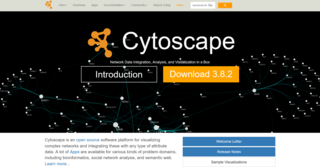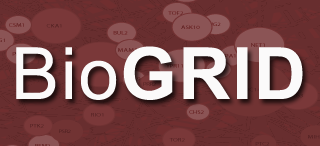| Content | |
|---|---|
| Description | extracellular matrix interactions database. |
| Data types captured | Interactions DataBase, Biochemestry, Biacore, SPR |
| Organisms | All (Human only possible) |
| Contact | |
| Laboratory | IBCP - UMR5086 CNRS / Univ Lyon1 - FRANCE |
| Authors | Emilie Chautard, Guillaume Launay, Nicolas Thierry-Mieg, Romain Salza, Franck Peysselon, Marie Fatoux-Ardore, Sofiane Badaoui, Sylvain Vallet, Lionel Ballut, Dorian Multedo, Sylvie Ricard-Blum. |
| Primary citation | PMID 20852260 |
| Access | |
| Standards | PSI-MI |
| Website | http://matrixdb.univ-lyon1.fr |
MatrixDB is a biological database focused on molecular interactions between extracellular proteins and polysaccharides. [1] MatrixDB takes into account the multimeric nature of the extracellular proteins (for example, collagens, laminins and thrombospondins are multimers). The database was initially released in 2009 [2] and is maintained by the research group of Sylvie Ricard-Blum at UMR5246, Claude Bernard University Lyon 1.

Biological databases are libraries of life sciences information, collected from scientific experiments, published literature, high-throughput experiment technology, and computational analysis. They contain information from research areas including genomics, proteomics, metabolomics, microarray gene expression, and phylogenetics. Information contained in biological databases includes gene function, structure, localization, clinical effects of mutations as well as similarities of biological sequences and structures.
In cell biology, molecular biology and related fields, the word extracellular means "outside the cell". This space is usually taken to be outside the plasma membranes, and occupied by fluid. The term is used in contrast to intracellular.

The Université Claude Bernard Lyon 1, is one of the three public universities of Lyon, France. The dominant areas of study covered by the university are science and medicine. The main administrative, teaching and research facilities are located in Villeurbanne. Other campus are the domains of Gerland, Rockefeller and Laennec. Attached to the University are the Hospices civils de Lyon including the "Centre hospitalier Lyon Sud", which is the largest teaching hospital in the Rhône-Alpes region and second largest in France.
MatrixDB is linked with UniGene and the Human Protein Atlas. It also allows users to build customised tissue- and disease-specific interaction networks, which can be further analysed and visualised using Cytoscape or Medusa. [1]
UniGene is a NCBI database of the transcriptome and thus, despite the name, not primarily a database for genes. Each entry is a set of transcripts that appear to stem from the same transcription locus. Information on protein similarities, gene expression, cDNA clones, and genomic location is included with each entry.
The Human Protein Atlas (HPA) is a Swedish-based program started in 2003 with the aim to map all the human proteins in cells, tissues and organs using integration of various omics technologies, including antibody-based imaging, mass spectrometry-based proteomics, transcriptomics and systems biology. All the data in the knowledge resource is open access to allow scientists both in academia and industry to freely access the data for exploration of the human proteome. The version 18 consists of three separate parts, each focusing on a particular aspect of the genome-wide analysis of the human proteins; the Tissue Atlas showing the distribution of the proteins across all major tissues and organs in the human body, the Cell Atlas showing the subcellular localization of proteins in single cells, and finally the new Pathology Atlas showing the impact of protein levels for survival of patients with cancer. The Human Protein Atlas program has already contributed to several thousands of publications in the field of human biology and disease and it was recently selected by the organization ELIXIR as a European core resource due to its fundamental importance for a wider life science community. The HPA consortium is funded by the Knut and Alice Wallenberg Foundation.

Cytoscape is an open source bioinformatics software platform for visualizing molecular interaction networks and integrating with gene expression profiles and other state data. Additional features are available as plugins. Plugins are available for network and molecular profiling analyses, new layouts, additional file format support and connection with databases and searching in large networks. Plugins may be developed using the Cytoscape open Java software architecture by anyone and plugin community development is encouraged. Cytoscape also has a JavaScript-centric sister project named Cytoscape.js that can be used to analyse and visualise graphs in JavaScript environments, like a browser.
MatrixDB is an active member of the International Molecular Exchange Consortium (IMEx), [3] a group of the major public providers of interaction data. Other participating databases include the Biomolecular Interaction Network Database (BIND), [4] IntAct, [5] the Molecular Interaction Database (MINT), [6] MIPS, [7] MPact, and BioGRID. [3] The databases of IMEx work together to prevent duplications of effort, collecting data from non-overlapping sources and sharing the curated interaction data. The IMEx consortium also worked to develop the HUPO-PSI-MI XML standard format for annotating and exchanging interaction data. [3] [8] MatrixDB includes interaction data extracted from the literature by manual curation and offers access to relevant data involving extracellular proteins provided by IMEx partner databases through the PSICQUIC webservice, as well as data from the Human Protein Reference Database.

The Biological General Repository for Interaction Datasets (BioGRID) is a curated biological database of protein-protein interactions, genetic interactions, chemical interactions, and post-translational modifications created in 2003 (originally referred to as simply the General Repository for Interaction Datasets by Mike Tyers, Bobby-Joe Breitkreutz, and Chris Stark at the Lunenfeld-Tanenbaum Research Institute at Mount Sinai Hospital. It strives to provide a comprehensive curated resource for all major model organism species while attempting to remove redundancy to create a single mapping of data. Users of The BioGRID can search for their protein or publication of interest and retrieve annotation, as well as curated data as reported, by the primary literature and compiled by in house large-scale curation efforts. The BioGRID is hosted in Toronto, Ontario, Canada and Dallas, Texas, United States and is partnered with the Saccharomyces Genome Database. The BioGRID is funded by the BBSRC, NIH, and CIHR. BioGRID is a member of the International Molecular Exchange Consortium.
The Human Proteome Organization (HUPO) is an international consortium of national proteomics research associations, government researchers, academic institutions, and industry partners. The organization was founded in June 2001 and it promotes the development and awareness of proteomics research, advocates on behalf of proteomics researchers throughout the world, and facilitates scientific collaborations between members and initiatives. Ultimately, it is organized to gain a better and more complete understanding of the human proteome.
The Proteomics Standards Initiative (PSI) is a working group of Human Proteome Organization. It aims to define data standards for proteomics in order to facilitate data comparison, exchange and verification.







